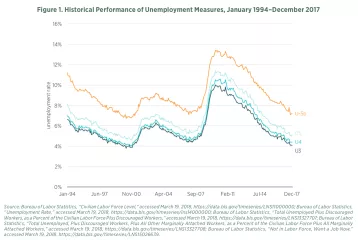- | Government Spending Government Spending
- | Expert Commentary Expert Commentary
- |
Not Working: How to Drive up Labor Force Participation
The US unemployment rate has fallen below 4 percent, a level reached only twice in the last half century. But labor force participation rates are also falling—they’re currently at around 63 percent. That means there are millions of Americans who don’t have a job but aren’t counted as unemployed because they are no longer looking for work.
Who are these people? Why are they not working? How can policymakers help?
To help get the best answers, the Mercatus Center at George Mason University recently brought together leading thinkers and practitioners in this area. The event, “A Wakeup Call for Today’s Modern Workforce,” was held May 11 in Washington, DC.
Work requirements, work availability, and education
Wall Street Journal economics correspondent Nick Timiraos moderated the first panel. It comprised Mercatus senior research fellow Jason Fichtner and Georgetown University professor of public policy Harry Holzer.
Holzer identified two main causes of low labor force participation rates:
- low job skills—it’s hard to earn a decent wage without some kind of post-secondary credential
- low job quality—fewer people actively look for jobs if wages and benefits are low and if they have access to programs such as Social Security Disability Insurance
Holzer identified two additional barriers to employment: opioid dependencies and criminal records. He was encouraged that experts across the political spectrum are coming together to find solutions to these challenges, and advocated moderate minimum wage increases and expanding the Earned Income Tax Credit (EITC).
Getting incentives right
Fichtner emphasized the importance of incentives. “You have to make the rewards to work greater than the rewards to not work,” he said. “That’s the key takeaway.”
Regarding work requirements for welfare recipients, Fichtner emphasized the need for more empirical research. “You don’t want to make policy by anecdote,” he said, but you do want policy reforms that help people up, not push them down.
For example, say someone from Allentown, Pennsylvania, wants a job—but the available job is at a new factory in Alabama. “How do you get them to say it’s time to pack up and move?” asked Fichtner. “Do you offer some sort of incentive package, whether it’s bonuses or the tax code or relocation assistance?”
Occupational licensure, vocational education
Holzer and Fichtner both addressed the issue of occupational licensure. “There are too many people who can have the appropriate training in Pennsylvania,” said Holzer, “and then if that same job opens up in a different state, your licensure will not be recognized.”
Citing the situation in Virginia, Fichtner highlighted another aspect of the licensure issue: “It shouldn’t take more hours of training to be a beautician than to carry a concealed handgun.”
Fichtner also stressed the need to promote blue-collar employment. “We need to have much better vocational tracks starting in high school,” he said. “European countries do this much better than we do.”
What about Bernie Sanders’ call for “guaranteed jobs”?
Holzer was skeptical about guaranteed jobs, preferring subsidized jobs instead. Fichtner warned that some people would quit an existing private-sector job to get such a government-guaranteed job. In effect, the government would be paying to create jobs that already existed.
How expensive would the Sanders proposal be? Fichtner estimated that if 20 to 30 million took up such a job, the cost would be between one and two trillion dollars a year. “Social Security’s outlays are about a trillion dollars a year!” he added, putting the scale of Sanders’ proposal in context.
What can help Americans find jobs
Mercatus senior research fellow Veronique de Rugy moderated the second panel. She brought in to the discussion those with on-the-ground experience—professionals who have worked with federal programs that seek to improve people’s skills and employment prospects.
A hodgepodge of programs
Mason Bishop, former Deputy Assistant Secretary, Employment and Training Administration, US Department of Labor, lamented the “hodgepodge” of federal programs. This posed real challenges at the state and local levels.
In agreement was Sharon Johnson, CEO of the Shenandoah Valley Workforce Development Board and Chair of the Virginia Association of Workforce Directors. “In Virginia, we have 24 workforce programs under eight different state agencies,” she revealed. Mardy Leathers, Director of the Missouri Division of Workforce Development, said states needed flexibility in administering and integrating programs.
Job training and education
Montez King, Appointee to the President’s Task Force on Apprenticeship Expansion, highlighted another challenge: “Some of the people that you’re trying to provide training for through the system never had a job for more than six months. And you’re trying to provide training for a year!”
King said training should be fast tracked. But it should also be “stackable,” so that individuals can learn skills cumulatively, one accomplishable step at a time. It also has to be portable, producing a credential that is accepted nationwide.
Leathers emphasized the need to tie such a credential to community college–type training, but this did not require federal government involvement, he said. Industry associations could handle the task.
Outcomes, not processes
Johnson and King agreed that work requirements should not just seek to get people off the rolls and into any job, but onto a sustained career pathway. Leathers also stressed the importance of employment (and housing) in reducing recidivism rates.
Above all, Bishop argued, Congress should make program goals clear. “If you have a work requirement, what is the outcome you want the states to achieve? Not what process and what activities do you want to make them put people through.”

